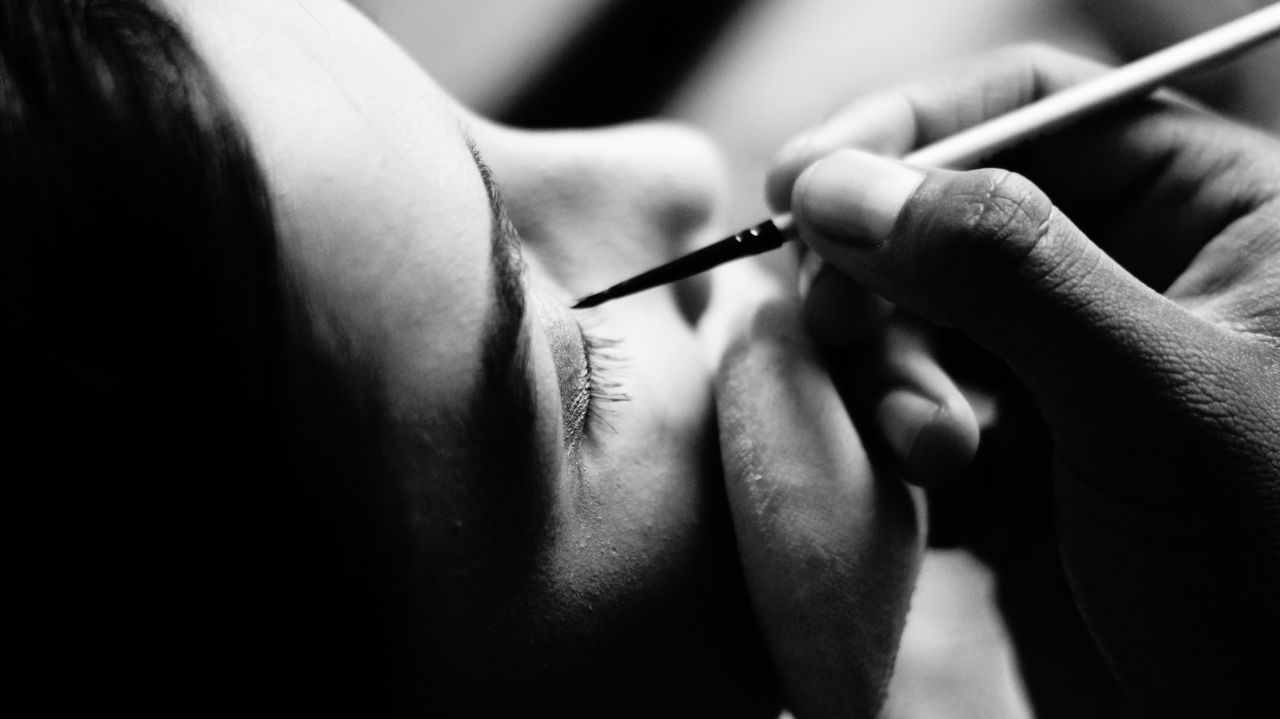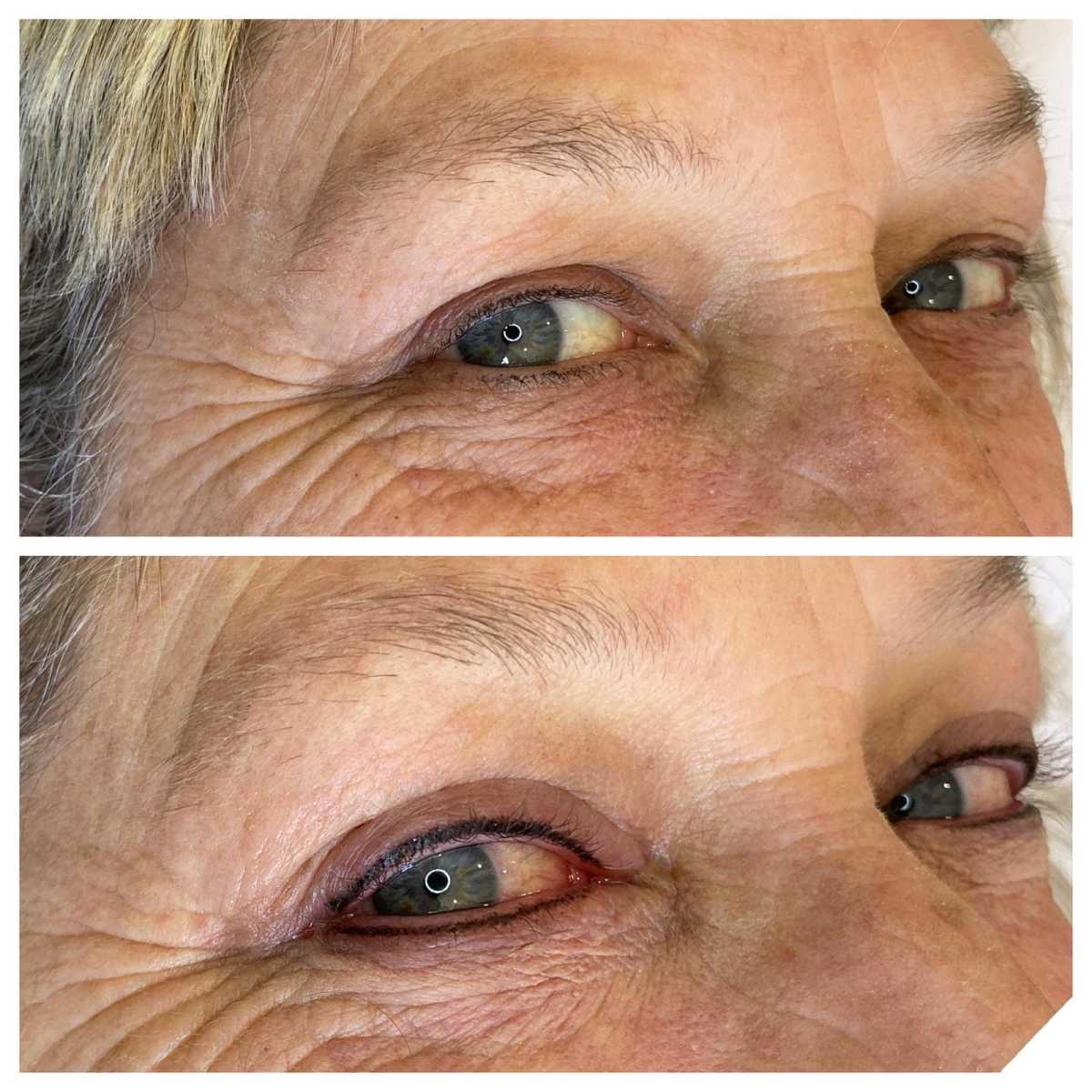Tattoo eyeliner, also known as permanent eyeliner, is a form of cosmetic tattooing that offers a semi-permanent solution for people who want a consistent and long-lasting eyeliner look. Despite the name, tattoo eyeliner is not truly permanent.
The ink used in cosmetic tattooing differs from traditional body tattoo ink and fades over time. Understanding the intricacies of this procedure, from how it’s done to the risks involved, is essential for anyone considering it.
Below, we’ll cover various aspects of tattoo eyeliner to give you a comprehensive overview.
Let’s get straight to the point
Tattoo eyeliner, often called permanent eyeliner, is a semi-permanent cosmetic procedure that provides a long-lasting eyeliner look, typically lasting 1 to 3 years. Unlike traditional tattoos, the ink fades due to its shallow application, sun exposure, and skin regeneration.
The procedure involves applying pigment along the lash line, with minimal discomfort thanks to numbing cream. The benefits include saving time, consistency, and cost savings in the long run, but proper aftercare is essential.
Risks include infection, allergic reactions, and pigment changes. To ensure a safe experience, choose a certified technician, avoid certain medications beforehand, and follow post-procedure care guidelines like avoiding eye makeup, eyelash curlers, and direct sunlight for several weeks.
Is Tattoo Eyeliner Permanent?
A common misconception about tattoo eyeliner is that it is permanent, like traditional body tattoos. However, the reality is a bit different. Tattoo eyeliner typically lasts between 1 to 3 years, depending on factors like skin type, lifestyle, and the quality of the ink used.
Why Does It Fade?
Unlike body tattoos, the ink used in cosmetic tattooing is not embedded as deeply into the skin. This shallower ink placement results in gradual fading. Sun exposure, skincare routines, and individual skin types all play roles in how quickly the pigment fades.
The body’s natural skin regeneration process leads to a slow breakdown of the pigment.
The Tattoo Eyeliner Procedure: What to Expect
If you’re curious about how the process works, the procedure for applying tattoo eyeliner involves a few steps, each designed to ensure the safest and most accurate results.
Preparation
Before the procedure begins, your technician will apply an antibiotic ointment to ensure your eye area remains sterile. Numbing cream is then used to minimise discomfort.
Once your eyes are prepped, a specialised tattoo machine is used to inject the pigment along the lash line.
Application Process
The technician will use a fine needle to inject tiny droplets of pigment between the lashes and under the skin. Depending on your desired look and the density of colour required, multiple passes may be needed to achieve the best results.
The entire process can take one to two hours, and touch-ups might be necessary after a few weeks to perfect the final look.
The Benefits of Permanent Eyeliner
Despite some risks and the necessity for careful aftercare, many people find the benefits of tattooed eyeliner to far outweigh any drawbacks.
Time-Saving
One of the biggest advantages is the time saved each morning. With permanent eyeliner, there’s no need to spend time applying makeup daily. It’s especially useful for those with busy lifestyles, athletes, or people with visual impairments or dexterity issues.
Consistency
Another advantage is the consistent look it provides. No more worrying about smudging or uneven application. Whether you’re at the gym, swimming, or just out for a long day, your eyeliner will stay intact.
Long-Term Cost Savings
Although tattoo eyeliner involves an upfront cost, it can save money in the long run. No more purchasing eyeliner pencils, gels, or liquid eyeliners, and less need for makeup remover products.
The initial investment in tattoo eyeliner can pay off in both time and money saved over the years.
Is Getting Tattoo Eyeliner Safe?
Safety is a significant concern for anyone considering a cosmetic procedure, especially one so close to the eyes. The key to ensuring a safe procedure lies in choosing a trained, experienced, and certified technician.
In Australia, cosmetic tattoo artists are required to meet stringent health and safety standards.
Pre-Procedure Considerations
Before getting tattoo eyeliner, it’s essential to avoid blood-thinning medications such as aspirin and ibuprofen for at least a week. These medications increase the risk of bleeding and bruising during the procedure.
You should also refrain from consuming alcohol for at least 24 hours before your appointment.
Risks and Side Effects
Even with the best precautions, there are some risks involved with tattoo eyeliner. These include infection, allergic reactions, and potential changes in the colour of the pigment over time.
In rare cases, pigments may migrate, spreading beyond the intended area. Proper aftercare and ensuring that the procedure is carried out in a sterile environment are crucial in reducing these risks.
Does Tattoo Eyeliner Hurt?
A common question people have is whether getting tattooed eyeliner hurts. The short answer is that it varies from person to person.
However, most people report that the pain is minimal, especially with the application of numbing cream.
Client Experience
The sensation is often described as a mild vibration or slight pressure on the eyelids. While some clients may feel discomfort, most are surprised at how painless the procedure is.
Additional numbing agents can be applied throughout the process to ensure the client remains comfortable.
What to Expect After Getting Tattoo Eyeliner?
The healing process is relatively quick but requires careful aftercare to avoid complications.
Immediate Aftermath
Directly after the procedure, it’s normal for the eyelids to appear swollen and the eyeliner to look thicker than expected. This is due to temporary inflammation, which subsides within a few days. After 2 to 3 days, the eyeliner will shrink to its final appearance.
Aftercare Guidelines
Proper aftercare is essential to prevent infection and ensure the best long-term results. For the first week, it’s important to keep the area dry and avoid rubbing the eyes.
Refrain from wearing eye makeup for at least a few days. Additionally, avoid using eyelash curlers and avoid direct sun exposure or tanning beds for at least four weeks.
Common Mistakes in Tattooed Eyeliner
While tattooed eyeliner is a fantastic solution for many, mistakes can happen, either due to poor technique or improper aftercare.
Wrong Pigment Choice
One of the most common issues is choosing the wrong pigment colour. Many people opt for black eyeliner, which can turn blue or green as it fades.
A skilled technician will recommend a pigment that suits your skin tone and will age well over time, often opting for dark browns instead of stark black.
Incorrect Shape or Application Depth
Another issue arises when the eyeliner’s shape doesn’t complement the client’s facial structure, or the technician applies the pigment too deeply. This can result in a bluish hue to the eyeliner as the pigment interacts with deeper skin layers.
Ensuring the technician is well-versed in applying the eyeliner at the correct depth is crucial for a successful outcome.
What Should You Avoid After Getting Tattoo Eyeliner?
Post-procedure care is just as important as the application process itself. There are certain actions you should avoid to ensure proper healing and long-lasting results.
Things to Avoid
- Eyelash Curlers: Avoid using eyelash curlers for at least two weeks after the procedure to prevent irritation and pigment migration.
- Waterproof Mascara: Use only non-waterproof mascara after your eyeliner has healed, as waterproof formulas can be harder to remove and may irritate the healing skin.
- Direct Sunlight: Stay away from direct sunlight and tanning beds for about four weeks, as UV rays can affect the colour of the pigment.
- Eye Makeup: Refrain from wearing eye makeup for a week to avoid infections and give your eyeliner time to heal properly.
Conclusion
Tattoo eyeliner offers a semi-permanent solution for those looking for a consistent, low-maintenance makeup look. While it requires an initial investment of time and money, the long-term benefits of convenience, cost savings, and smudge-proof eyeliner can make it worthwhile for many individuals.
However, it’s essential to choose a skilled and certified technician to minimise risks, and to follow proper aftercare guidelines to ensure the best results.
FAQs Tattoo Eyeliner
How Long Does Tattoo Eyeliner Last?
On average, tattoo eyeliner lasts between 1 to 3 years. Factors like skin type and sun exposure can affect its longevity.
Can I Remove Tattoo Eyeliner If I Don’t Like It?
Yes, tattoo eyeliner can be removed using laser tattoo removal methods, but this process can be costly and may require multiple sessions.
Is It Safe For People With Sensitive Skin?
While many people with sensitive skin can tolerate tattoo eyeliner, it’s important to do a patch test beforehand to ensure there are no allergic reactions to the pigment.
Can I Wear Contact Lenses After Getting Tattoo Eyeliner?
It is recommended to avoid wearing contact lenses during the procedure and for at least 1 to 2 days afterwards. This allows your eyes to heal and prevents irritation or infection. Always consult your technician for specific aftercare instructions.
How Soon Can I Get A Touch-Up If Needed?
Typically, a touch-up can be done 4 to 6 weeks after the initial procedure. This allows enough time for the skin to heal and the pigment to settle. Touch-ups are often necessary to perfect the shape and colour of the eyeliner, ensuring it meets your expectations.



